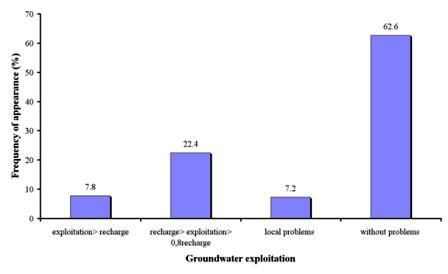Ground water exploitation
Agriculture plays a major role in water extraction and consumption especially in Mediterranean coastal areas where intensive irrigated horticulture is widespread. Nevertheless, in many areas a large contribution to aquifers overexploitation is due to the industrial and residential sectors and, seasonally, to tourism. Ground water exploitation can be estimated by "the exploitation index" that is defined as withdrawal of conventional freshwater resources (surface and groundwater) over total renewable resources (expressed in %). Ground water over-exploitation describes the degree to which the amount of water pumped from aquifers is sustainable in relation to the water that is available. This indicator considers the potential supply in relation to what is actually used. Over-exploitation can be quantitatively analyzed by comparing groundwater natural recharge quantities with the quantities of water actually used, but it can also be seen from undesirable effects such as the drawdown in well, drying up of rivers and springs. Specifically, this indicator is estimated by assessing: (a) water consumption by various sectors, (b) the decrease in river and spring flow, ground water monitoring, and (c) comparing by an appraisal of the natural recharge rate in a certain hydrological area.
As Table 2 shows, water exploitation characteristics have been collected in 361 field sites, corresponding to 5 study sites. The obtained data from the questionnaires showed that ground water exploitation trends is without problems of over-exploitation in the majority (62.6%) of the study field sites (Fig. 13), particularly in the sites of Djanybek-Russia, Novij Saratov-Russia and in some cases in Boteti Area-Botswana and Crete-Greece. The ground water exploitation is greater than 80% of recharge but recharge never reach to the quantities consumed by the various users in 22.4% of the study field sites (some cases in Crete-Greece). Some local problems of over-exploitation and over-exploitation in the broad scale of the study sites have been found in some field sites in Boteti Area-Botswana and in the whole area Nestos Basin Maggana-Greece (Fig 13).

Fig. 13 . Ground water exploitation trends prevailing in the study field sites